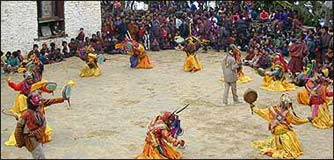 |
|
Festivals
in Bhutan
|
 |
 |
 |
Bhutan
Festivals |
|
 |
Bhutan
Festivals |
|
|
|
 |
 |
| The drametse ngacham being performed at the Tshechu
The
Yon-Phuel Lhakhang resonates with the blaring sound of religious musical
instruments and the latest Bhutanese music in the background as hundreds
of people squeeze their way to witness a dance or to try their luck in
a fair stall during the annual tsechu in Trashigang. |
|
 The
drametse ngacham being performed at the tsechu The
drametse ngacham being performed at the tsechu |
Yon-Phuel
Tsechu has undergone a transition," recalls 62-year oldWangdi from Pangthang,
who has not missed the tsechu for about a decade. Ten years ago,
only a few villagers came to witness the tsechu butnow every year apart
from the large crowd that the tsechu attracts,many fair stalls and makeshift
huts serving as temporary shops has added to the charm of the tsechu. While
some come to witness the festival, there are a few whopurposely come to
shop during the tsechu because in a remote placelike this social gatherings
are very rare and shops very few, said a regular visitor. Some Thimphu
based businessmen have also come all the way to decorate the tsechu with
electric rice cookers, water boilers and evenelectric pans. One significant
change at the tsechu according to the Kanglung gupis the decrease in alcohol
consumers.
"Many
villagers, under the influence of alcohol spent nights in the open air
and went back home completely broke. It was a sort of drinking festival
some years back, but now it has changed," the gup said. "To many the Yon-Phuel
Tsechu is also known as kholong tsechu, (kholong meaning to brawl)," explained
a village elder.
 The
great saint Terton Pema Lingpaon The
great saint Terton Pema Lingpaon |
The
unique Yon-Phul Tsechu not only differs from other festivals in the east
but also plays an important role in keeping the spiritual tradition alive
of a very close-knit community. Yon-Phuel Tsechu, as its name describes,
received its name when the community of Yonphu out of desperation offered
a plot of land as choe-yon or holy offering to the great saint Terton Pema
Lingpaon his visit to eastern Bhutan.
According
to Pangthang Lam Singye Wangchuk who conducts the annual tsechu, the community
of Yonphu (including the villages of Mertsam, Kanglung, Yonphula, Pangthang)
has heard about the great terton's visit, but since they did not have anything
worthy to offer, they offered a plot of land, which belonged to the community.
The
great saint in return, built a monastery on the same plot and created a
tsehchu to invoke the deities of the tantric teaching and remove the misfortune
of the community through mask dances.
 Celebrating
the Tsechu in the Peling tradition Celebrating
the Tsechu in the Peling tradition |
Here
after, the community of Yonphu celebrated the Yon-Phuel Tsechu in the famous
Peling tradition. Unlike other tsechus in the east the Yon-Phuel Tsechu
is celebrated thrice in a year under different names. And the community
still equally enjoys the blessing.
 The
villagers organize the festival themselves The
villagers organize the festival themselves |
Shouldering
responsibilities themselves the three-day tsechu is solely organized and
performed by the villagers themselves. While layman perform the dances
and villagers contribute food grains to sustain the three-day festival,
businessmen also contribute money during all the three tsechus.
Kanglung
gup Ugyen Dorji told that contribution was compulsory when the tsechu
first started about 370 years ago. "Apart from cash, about 250 households
still contribute rice, wine, kharang and diary products to keep the tradition
alive," said the gup.
"Nobody
sponsored the tsechu, but the tsechu although cashs trapped still continues
to keep an age old tradition. By witnessing such an important festival
ordinary people come to know their place in the history of the country,"
he added.
Several
hundred devotees from as far as Womrong in the south and Yangtse in the
north attended the three-day tsechu that endedearlier this week by reveling
to the public the sacred relics of the Yon-Phuel lhakhangs.
|



